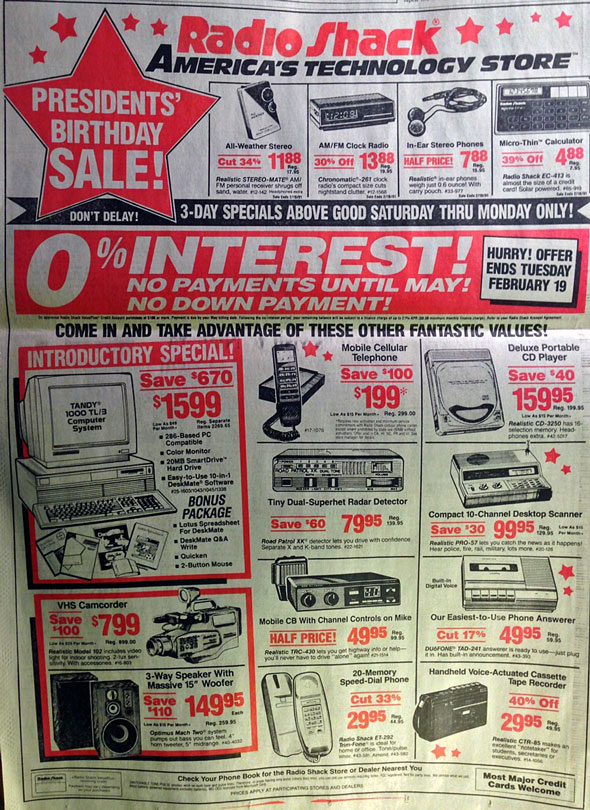Look at the 1991 Radio Shack ads below.
As the author of the piece I’ve borrowed this from states, “There are 15 electronic gimzo type items on this page, being sold from America’s Technology Store. 13 of the 15 you now always have in your pocket.” Here is the list of the items above which are now conveniently on your iPhone:
- All weather personal stereo, $11.88. I now use my iPhone with an Otter Box
- AM/FM clock radio, $13.88. iPhone.
- In-Ear Stereo Phones, $7.88. Came with iPhone.
- Microthin calculator, $4.88. Swipe up on iPhone.
- Tandy 1000 TL/3, $1599. I actually owned a Tandy 1000, and I used it for games and word processing. I now do most of both of those things on my phone.
- VHS Camcorder, $799. iPhone.
- Mobile Cellular Telephone, $199. Obvs.
- Mobile CB, $49.95. Ad says “You’ll never drive ‘alone’ again!” iPhone.
- 20-Memory Speed-Dial phone, $29.95.
- Deluxe Portable CD Player, $159.95. 80 minutes of music, or 80 hours of music? iPhone.
- 10-Channel Desktop Scanner, $99.55. I still have a scanner, but I have a scanner app, too. iPhone.
- Easiest-to-Use Phone Answerer, $49.95. iPhone voicemail.
- Handheld Cassette Tape Recorder, $29.95. I use the Voice Memo app almost daily.
- BONUS REPLACEMENT: It’s not an item for sale, but at the bottom of the ad, you’re instructed to ‘check your phone book for the Radio Shack Store nearest you.’ Do you even know how to use a phone book?
All this was $3054.82 in 1991 (about $5100 in 2012 dollars) and has been “replaced by the 3.95 ounce bundle of plastic, glass, and processors in our pockets” (which is about $200 nowadays). A few years ago, Reason‘s science correspondent Ronald Bailey wrote on the concept of “dematerialization”:
Jesse Ausubel, director of the Program for the Human Environment at Rockefeller University and Paul Waggoner at the Connecticut Agricultural Experiment Station, show that the world economy is increasingly using less to produce more. They call this process “dematerialization.” By dematerialization, they mean declining consumption of energy or goods per unit of GDP. In a 2008 article in the Proceedings of the National Academy of Sciences, Ausubel and Waggoner, using data from 1980 to 2005, show that the world is on a dematerialization binge, wringing ever more value from less material. It turns out that dematerialization achieves many of the same environmental goals as deconsumption.
Ausubel and Waggoner demonstrate that the global economy dematerialized (got more outputs from fewer inputs) steadily in the production of crops, use of fertilizer and wood, and carbon dioxide emissions. For example, while global per capita income rose by 40 percent between 1980 and 2005, farmers around the world raised crop yields 57 percent. Had farming productivity remained stuck at the 1980 level, farmers would have had to plow down an additional 1 billion hectares (about half the land area of the U.S. and six times current U.S. cropland) to produce the amount of food grown in 2005. Instead cropland expanded by less than 100 million hectares and farmers so boosted their productivity that they could produce the same amount of crops on only 60 percent of the amount of land they used in 1980.
The world economy emitted more carbon dioxide in 2005 than it did in 1980, but nearly 30 percent less than it would have had emissions grown at the same rate as the world economy grew. Using European Carbon Exchange prices per ton of carbon dioxide, Ausubel and Waggoner calculate that this dematerialized carbon would be worth nearly $400 billion dollars per year.
As the Cato Institute’s Marian Tupy notes, “Dematerialization, in other words, should be welcome news for those who worry about the ostensible conflict between the growing world population on the one hand and availability of natural resources on the other hand. While opinions regarding scarcity of resources in the future differ, dematerialization will better enable our species to go on enjoying material comforts and be good stewards of our planet at the same time. That is particularly important with regard to the people in developing countries, who ought to have a chance to experience material plenty in an age of rising environmental concerns.”


Great use of the Radio Shack ad! Think of the difference between an electronics store in the 1970s and an Apple store today.